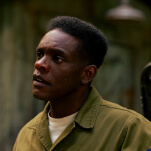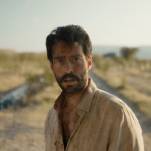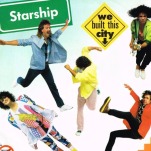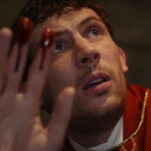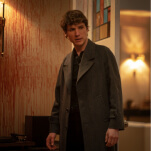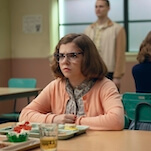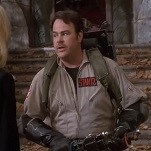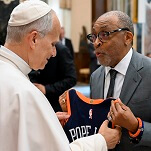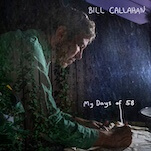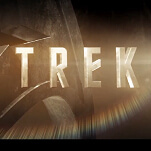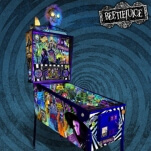It’s true that, before George Romero’s Night Of The Living Dead traumatized a generation of kids like the crowd Roger Ebert described in his review, zombies were simply an obscure creature from Haitian folklore. By relocating his “ghouls” to present-day America and giving them an appetite for human flesh, Romero created a new kind of monster, one that reflected uniquely modern anxieties in the wake of the senseless carnage of the Vietnam War. There would be no zombie conventions, no zombie pub crawls, no Walking Dead, and no World War Z without him. But to merely call Romero the father of the modern zombie, as immense of a contribution as that is, is to underestimate his influence. In fact, Romero himself would tell any interviewer who asked throughout his career that he was capable of more than undead mayhem. Because without Romero, not only zombies, but independent filmmaking in general, would look very different.
Romero co-founded his first production company, Latent Image, in 1962, two years after graduating from Carnegie Mellon University in Pittsburgh. (Ironically, Romero, whose name has become so closely associated with the Steel City, was born and raised in the Bronx.) Latent Image specialized in commercials and industrial films—Iron City Beer was one of its biggest clients—and the hands-on experience gave Romero a practicality that would come to inform his filmmaking philosophy. An early effort at a feature film, an anthology called Expostulations, never made it past the demo reel stage, but in 1967 he and a group of nine investors pooled their money to form a new company, Image Ten, with the express goal of making and releasing their own feature film.
At the time, this was an extremely audacious plan, one that would have been unthinkable just a few years before. In 1967, although the studio system of old Hollywood was in decline, the career path of financing a film independently, getting it into a film festival, and being discovered there—the fuel behind the ’90s indie boom that launched Quentin Tarantino and Steven Soderbergh—didn’t really exist yet. And the midnight movie phenomenon was still a couple of years out, so finding cult success that way wasn’t an option either. So Romero and company decided to take a cue from smaller studios like Roger Corman’s American International Pictures and make a film they could sell specifically on the drive-in circuit, hoping to raise some quick cash to get their company off the ground.
And so, after completing Night Of The Living Dead, then known as Night Of The Flesh Eaters, Romero literally put a copy of the film in the trunk of his car and hand-delivered it to distributors in New York. After being summarily rejected by every major company Romero approached, Image Ten eventually settled for Continental Distributing, an arthouse outfit that failed to register the copyright when changing the title from Night Of The Flesh Eaters to Night Of The Living Dead, unleashing a tsunami of unauthorized releases that continues to this day. (That’s why characters in movies are always watching Night on TV; what other film is instantly recognizable and free to use however you like?)
Although Romero was beat to the market by John Cassavetes, whose 1968 film Faces was one of the first truly independent productions to break through to the mainstream, Night was a much bigger commercial success, eventually making $50 million on a $114,000 budget. And while Romero and his colleagues didn’t get to share in the film’s success financially—something Romero remained bitter about for decades—they did prove that you didn’t have to work within the studio system, or the bohemian New York film scene of Cassavetes, Brian De Palma, and Martin Scorsese, for that matter, to make a successful feature. A banner at its world premiere on Halloween night (financed, naturally, by Romero’s production company) touted Night as “Pittsburgh’s first feature film!,” a declaration of hometown pride whose echoes can be felt in John Waters’ loyalty to his beloved Baltimore and Richard Linklater’s Austin-centric filmography.
And indeed, after the success of Night, Romero continued to defy the conventional wisdom that “making it” meant being absorbed into the Hollywood system and kept making movies in Pittsburgh. It was during this period that Romero produced some of his most challenging, and least commercially successful, fare: There was Season Of The Witch, a.k.a. Jack’s Wife (1973), a riff on suburban co-option of the counterculture that was drastically cut and released on the drive-in circuit as a softcore film called Hungry Wives, the nuclear-age apocalyptic terror of The Crazies (1973), and the unsung masterpiece Martin (1977), an ahead-of-its-time character-driven drama/horror hybrid of the sort that re-emerges, and is hailed as a new innovation in the medium, every couple of decades or so. Then came Dawn Of The Dead (1978), shot at night at the Monroeville Mall in suburban Pittsburgh, re-imagining the cheerful consumerists who flocked there during the day as a mindless undead horde.
After Dawn Of The Dead proved to be his second breakout hit, Romero did eventually make his way to Hollywood in the ’80s, maintaining a production base in Pittsburgh all the while. While he was out West, he made a handful of studio features, like 1982’s Creepshow, a tribute to Romero’s beloved EC Comics and a cult classic in its own right. But he found the experience creatively unfulfilling and frankly rather boring—unsurprising for a director who stubbornly maintained his independence formally as well as financially throughout his career. There are whole other essays to be written about Romero’s unnerving “staccato” editing style, and much can be and has been said about his profound influence on the idea of the monster movie as sociopolitical metaphor.
Jordan Peele, whose breakout directorial debut and self-proclaimed “social thriller” Get Out can trace its lineage directly back to Romero’s work, stated it simply when he said, “Romero started it,” alongside a picture of Night Of The Living Dead’s Duane Jones, the first black actor to star in an American horror film. Romero would have appreciated Peele’s directness, as he remained similarly plainspoken throughout his life. His commitment to his ideals got him in trouble with studios, and he spent much of his career battling producers and distributors he felt had taken advantage of him. But that was fine, because he had little use for snakes in designer suits. (There’s a reason Night was embraced so heartily by the counterculture of the late ’60s.)
Romero was stubborn and tenacious, telling The Village Voice’s Tom Allen in 1979 that in life, as in filmmaking, “it’s a matter of hanging on, whatever it takes.” He embraced new technologies that would allow directors to work independently, first home video, then digital cameras, and eventually crowdfunding. His latest, and now final, project, Road Of The Dead, written and produced by Romero and directed by his longtime second unit director Matt Birman, is set to appear at the Fantasia International Film Festival’s Frontières market in search of funding next weekend. He provided an example that has inspired everyone from Edgar Wright to Jeremy Saulnier to make their dreams a reality no matter what it takes, and every time an aspiring director launches an Indiegogo campaign for a low-budget film, they’re participating in his legacy. So if you want to pay tribute to George Romero, don’t just re-watch Dawn Of The Dead or Night Of The Living Dead, although those are both essential viewing. Be like George, and make your own damn movie.
